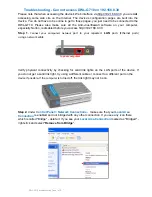
Prestige 2602HW Series User’s Guide
Chapter 9 Introduction to VoIP
125
C
H A P T E R
9
Introduction to VoIP
This chapter provides background information on VoIP and SIP.
9.1 Introduction to VoIP
VoIP is the sending of voice signals over the Internet Protocol. This allows you to make phone
calls and send faxes over the Internet at a fraction of the cost of using the traditional circuit-
switched telephone network. You can also use servers to run telephone service applications
like PBX services and voice mail. Internet Telephony Service Provider (ITSP) companies
provide VoIP service. A company could alternatively set up an IP-PBX and provide it’s own
VoIP service.
Circuit-switched telephone networks require 64 kilobits per second (Kbps) in each direction to
handle a telephone call. VoIP can use advanced voice coding techniques with compression to
reduce the required bandwidth.
9.2 SIP
The Session Initiation Protocol (SIP) is an application-layer control (signaling) protocol that
handles the setting up, altering and tearing down of voice and multimedia sessions over the
Internet.
SIP signaling is separate from the media for which it handles sessions. The media that is
exchanged during the session can use a different path from that of the signaling. SIP handles
telephone calls and can interface with traditional circuit-switched telephone networks.
9.2.1 SIP Identities
A SIP account uses an identity (sometimes referred to as a SIP address). A complete SIP
identity is called a SIP URI (Uniform Resource Identifier). A SIP account's URI identifies the
SIP account in a way similar to the way an e-mail address identifies an e-mail account. The
format of a SIP identity is SIP-Number@SIP-Service-Domain.
9.2.1.1 SIP Number
The SIP number is the part of the SIP URI that comes before the “@” symbol. A SIP number
can use letters like in an e-mail address ([email protected] for example) or numbers
like a telephone number ([email protected] for example).
9.2.1.2 SIP Service Domain
The SIP service domain of the VoIP service provider is the domain name in a SIP URI. For
example, if the SIP address is
, then “VoIP-provider.com” is
the SIP service domain.
Summary of Contents for Prestige 2602HW Series
Page 2: ......
Page 22: ...Prestige 2602HW Series User s Guide 22...
Page 30: ...Prestige 2602HW Series User s Guide 30...
Page 36: ...Prestige 2602HW Series User s Guide 36...
Page 40: ...Prestige 2602HW Series User s Guide 40 Introduction to DSL...
Page 72: ...Prestige 2602HW Series User s Guide 72 Chapter 4 Password Setup...
Page 102: ...Prestige 2602HW Series User s Guide 102 Chapter 6 Wireless LAN Setup...
Page 112: ...Prestige 2602HW Series User s Guide 112 Chapter 7 WAN Setup...
Page 124: ...Prestige 2602HW Series User s Guide 124 Chapter 8 Network Address Translation NAT Screens...
Page 130: ...Prestige 2602HW Series User s Guide 130 Chapter 9 Introduction to VoIP...
Page 142: ...Prestige 2602HW Series User s Guide 142 Chapter 10 Voice Screens...
Page 148: ...Prestige 2602HW Series User s Guide 148 Chapter 12 Time and Date...
Page 162: ...Prestige 2602HW Series User s Guide 162 Chapter 13 Firewalls...
Page 192: ...Prestige 2602HW Series User s Guide 192 Chapter 16 Remote Management Configuration...
Page 206: ...Prestige 2602HW Series User s Guide 206 Chapter 17 Universal Plug and Play UPnP...
Page 212: ...Prestige 2602HW Series User s Guide 212 Chapter 18 Logs Screens...
Page 214: ...Prestige 2602HW Series User s Guide 214 Chapter 19 Maintenance Figure 102 System Status...
Page 224: ...Prestige 2602HW Series User s Guide 224 Chapter 19 Maintenance...
Page 232: ...Prestige 2602HW Series User s Guide 232 Chapter 20 Introducing the SMT...
Page 236: ...Prestige 2602HW Series User s Guide 236 Chapter 21 Menu 1 General Setup...
Page 240: ...Prestige 2602HW Series User s Guide 240 Chapter 22 Menu 2 WAN Backup Setup...
Page 244: ...Prestige 2602HW Series User s Guide 244 Chapter 23 Menu 3 LAN Setup...
Page 248: ...Prestige 2602HW Series User s Guide 248 Chapter 24 Wireless LAN Setup...
Page 254: ...Prestige 2602HW Series User s Guide 254 Chapter 25 Internet Access...
Page 268: ...Prestige 2602HW Series User s Guide 268 Chapter 27 Static Route Setup...
Page 272: ...Prestige 2602HW Series User s Guide 272 Chapter 28 Bridging Setup...
Page 288: ...Prestige 2602HW Series User s Guide 288 Chapter 29 Network Address Translation NAT...
Page 304: ...Prestige 2602HW Series User s Guide 304 Chapter 31 Filter Configuration...
Page 324: ...Prestige 2602HW Series User s Guide 324 Chapter 34 System Information and Diagnosis...
Page 340: ...Prestige 2602HW Series User s Guide 340 Chapter 35 Firmware and Configuration File Maintenance...
Page 346: ...Prestige 2602HW Series User s Guide 346 Chapter 36 System Maintenance...
Page 350: ...Prestige 2602HW Series User s Guide 350 Chapter 37 Remote Management...
Page 362: ...Prestige 2602HW Series User s Guide 362 Chapter 39 Call Scheduling...
Page 366: ...Prestige 2602HW Series User s Guide 366 Chapter 40 Internal SPTGEN...
Page 372: ...Prestige 2602HW Series User s Guide 372 Chapter 41 Troubleshooting...
Page 376: ...Prestige 2602HW Series User s Guide 376 Appendix A Hardware Specifications...
Page 396: ...Prestige 2602HW Series User s Guide 396 Appendix C IP Subnetting...
Page 402: ...Prestige 2602HW Series User s Guide 402 Appendix E Wireless LAN and IEEE 802 11...
Page 409: ...Prestige 2602HW Series User s Guide Appendix H Triangle Route 409...
Page 410: ...Prestige 2602HW Series User s Guide 410 Appendix H Triangle Route...
Page 434: ...Prestige 2602HW Series User s Guide 434 Appendix J Command Interpreter...
Page 436: ...Prestige 2602HW Series User s Guide 436 Appendix K Firewall Commands...
















































